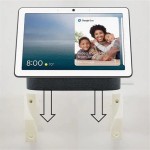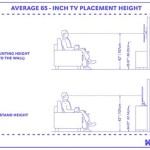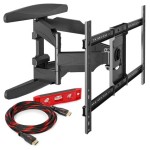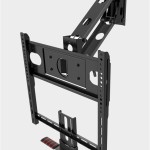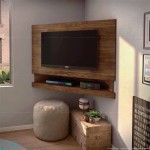Mounting a TV on a Wall Without Studs: A Comprehensive Guide
Mounting a television on a wall offers a sleek, modern aesthetic and can optimize space within a room. While traditionally, finding and utilizing wall studs provides the most secure mounting solution, circumstances often arise where studs are inaccessible or positioned inconveniently. This article details viable alternatives for safely and effectively mounting a television on a wall in the absence of studs.
Before initiating any mounting project, it is imperative to prioritize safety and accuracy. Consider the weight of the television, the type of wall material, and the intended viewing angle. Rushing the process or employing inadequate tools and methods can lead to television damage, wall damage, or even personal injury. Always consult the television's user manual and the mounting hardware instructions for specific guidelines and weight limitations.
Understanding Wall Types and Their Load-Bearing Capacities
Different wall types possess varying load-bearing capabilities, which directly influence the feasibility of mounting a television without studs. Common wall types include drywall, plaster, and concrete. Drywall, also known as gypsum board, is the most prevalent type of wall in residential construction. It is relatively inexpensive and easy to install, but it offers minimal resistance to weight, particularly when hanging heavy objects. Plaster walls, typically found in older homes, are more durable than drywall but still require careful consideration. Concrete walls, frequently encountered in basements or commercial buildings, provide the strongest support but necessitate specialized drilling equipment and anchoring techniques.
Identifying the wall type is the first step in determining the appropriate mounting strategy. A simple test involves gently pressing on the wall. Drywall will often feel slightly soft or flexible, while plaster will feel harder and more rigid. Concrete will be unmistakably dense and unyielding. If unsure, consulting a professional is advisable, particularly before drilling any holes.
Knowing the weight of the television is equally crucial. This information is typically found in the television's user manual or on a sticker located on the back of the unit. The combined weight of the television and the mounting bracket should be significantly less than the maximum weight capacity of the chosen wall anchor system. It is prudent to err on the side of caution and select anchors with ample safety margins.
Exploring Alternative Anchoring Solutions for Stud-Free Mounting
When studs are unavailable, several alternative anchoring solutions can be employed to securely mount a television. These solutions rely on various mechanisms to distribute the weight of the television across a larger surface area of the wall, reducing the stress on any single point. Selecting the appropriate anchor depends on the wall type and the weight of the television.
Toggle Bolts: Toggle bolts are one of the most reliable options for mounting heavy objects on drywall. They consist of a bolt and a wing-like toggle that folds flat to pass through a pre-drilled hole. Once inside the wall cavity, the toggle springs open, creating a broad anchor that distributes the weight across a large area. Toggle bolts are available in various sizes and weight capacities, making them suitable for a wide range of television sizes. Installation requires drilling a hole large enough to accommodate the folded toggle, inserting the bolt and toggle assembly through the hole, and then tightening the bolt until the toggle is firmly pressed against the back of the wall. Proper installation is crucial to ensure the toggle opens fully and creates a secure hold. Over-tightening can damage the drywall.
Molly Bolts (Sleeve Anchors): Molly bolts, also known as sleeve anchors, are another type of anchor that expands behind the drywall to provide a strong hold. They consist of a bolt and a sleeve that collapses and expands as the bolt is tightened. This expansion creates a wider contact area on the back of the drywall, distributing the weight more evenly. Molly bolts are relatively easy to install, requiring only a pre-drilled hole and a screwdriver or wrench to tighten the bolt. However, they are generally less strong than toggle bolts and are more suitable for lighter televisions or smaller mounting brackets. As with toggle bolts, it is important to avoid over-tightening, which can damage the drywall.
Wall Anchors (Drywall Anchors): This category encompasses a broad range of anchors specifically designed for drywall. Plastic or metal self-drilling anchors are a common option. These anchors feature a pointed tip that allows them to be screwed directly into the drywall without pre-drilling. As they are screwed in, they expand or create threads in the drywall, providing a relatively secure hold. However, these anchors are generally not recommended for heavy televisions, as their weight capacity is limited. They are more suitable for lighter objects, such as small shelves or picture frames. When using self-drilling anchors, it is crucial to select an anchor with an appropriate weight capacity for the intended load and to avoid over-tightening, which can strip the threads in the drywall.
Heavy-Duty Drywall Anchors: For larger televisions, specialized heavy-duty drywall anchors are available. These anchors are designed to provide significantly greater weight capacity than standard drywall anchors. They often feature a combination of expanding sleeves, multiple contact points, or specialized locking mechanisms to ensure a secure hold. Examples include snap toggles and super anchors. While more expensive than standard anchors, they offer a higher level of security and are often necessary for safely mounting larger, heavier televisions on drywall without studs. Always follow the manufacturer's instructions carefully when installing heavy-duty drywall anchors, as proper installation is critical for achieving their rated weight capacity.
Adhesive Strips/Pads: Some manufacturers offer adhesive strips or pads designed for mounting lightweight items on walls. These strips typically utilize a strong adhesive to adhere to the wall surface and the back of the object being mounted. While convenient and easy to use, adhesive strips are generally not recommended for mounting televisions, as their weight capacity is limited and their long-term reliability can be questionable. The adhesive can weaken over time, potentially leading to the television falling off the wall. They are more suitable for very lightweight items, such as small mirrors or decorative plaques.
Regardless of the chosen anchor type, it is essential to select an anchor with a weight capacity that significantly exceeds the combined weight of the television and the mounting bracket. A safety factor of at least two is recommended, meaning the anchor should be rated to hold at least twice the weight of the television and bracket. This provides a margin of error and helps to ensure the long-term stability of the installation.
Implementing Safe Mounting Practices and Techniques
Beyond selecting the appropriate anchors, employing safe mounting practices and techniques is paramount. This includes careful planning, accurate measurements, and the use of appropriate tools. Neglecting these aspects can compromise the integrity of the installation and increase the risk of damage or injury.
Accurate Measurements and Leveling: Before drilling any holes, carefully measure and mark the desired location for the television. Use a level to ensure the mounting bracket is perfectly horizontal. Inaccurate measurements or a misaligned bracket can result in a crooked television, which is both aesthetically unappealing and potentially unstable. Use a stud finder to definitively confirm the absence of studs in the marked area before proceeding with stud-free mounting methods.
Proper Drilling Techniques: When drilling holes for the anchors, use a drill bit that is the correct size for the chosen anchors. Refer to the anchor manufacturer's instructions for the recommended drill bit size. Drill straight into the wall, applying steady pressure but avoiding excessive force. Angled or oversized holes can weaken the drywall and compromise the anchor's holding power. For concrete walls, use a hammer drill with a masonry bit and wear appropriate safety glasses and hearing protection.
Secure Fastening and Tightening: When installing the anchors, follow the manufacturer's instructions carefully. Ensure that the anchors are fully seated and that the bolts or screws are tightened securely. However, avoid over-tightening, as this can damage the drywall or strip the threads on the anchors. Use a torque wrench if necessary to ensure that the fasteners are tightened to the appropriate specification. Periodically check the tightness of the fasteners to ensure they haven't loosened over time.
Wire Management and Concealment: After mounting the television, address the issue of wire management. Loose wires can be unsightly and pose a safety hazard. Use cable ties, cable sleeves, or cord covers to organize and conceal the wires. Consider running the wires through the wall using a wall plate and in-wall rated cables. This creates a cleaner, more professional look. However, in-wall wiring requires knowledge of electrical codes and may necessitate hiring a qualified electrician.
Professional Consultation: If unsure about any aspect of the mounting process, consulting a professional installer is highly recommended. Experienced installers have the knowledge, skills, and tools necessary to safely and effectively mount televisions on various wall types. They can assess the specific circumstances of the installation, recommend appropriate anchors and techniques, and ensure that the television is securely mounted and properly wired.
Mounting a television on a wall without studs is achievable with proper planning, the selection of appropriate anchors, and the implementation of safe mounting practices. However, it is essential to recognize the limitations of stud-free mounting and to prioritize safety at all times. When in doubt, seeking professional assistance is always the prudent course of action.

How To Mount Tv On Wall No Studs

How I Hung My Tv With No Studs

Best Way To Attach Tv Mount Just Drywall

Mounting Tv On Plaster Wall No Studs

Mount It No Stud Tv Wall For Screens Up To 80 In Mi 376 The Home

How To Mount A Tv On The Wall Without Studs It

No Stud Tv Wall Mount Low Profile Heavy Duty Vesa For Up To 80 Inch Display 110lb 5

Mount It No Stud Tilting Tv Wall Fits 32 80 Tvs Capacity 110 Lbs Drilling Required Install With Nails Low Profile Wal Com

No Stud Tv Hanger Mount Supplier And Manufacturer Lumi

No Stud Tv Wall Mount For 32 To 75 Tvs Detailed Installation

